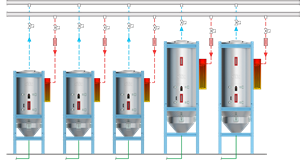Film Extruder Tries Do-It-Yourself Electric Power
One of the country’s largest makers of stretch film and bags, the Sigma Plastics Group based in Lyndhurst, N.J., has embarked on an experiment in generating its own electricity.
One of the country’s largest makers of stretch film and bags, the Sigma Plastics Group based in Lyndhurst, N.J., has embarked on an experiment in generating its own electricity. Last year Sigma leased a small gas-fired power-generating plant from Honeywell, which installed the plant in Sigma’s Lyndhurst industrial park.
Honeywell Home and Building Control in Morristown, N.J., runs and maintains the co-generating plant for Sigma under a seven-year lease and a management contract. Honeywell’s contract includes an on-site engineer and 24-hr surveillance of the power plant by Honeywell.
The package represents an investment of $6.5 million for Sigma, but after the lease expires, Sigma will own the equipment. Sigma ultimately will save a lot on energy because Honeywell guarantees at least $1.2 million/yr in cost savings after the lease is up. That includes Honeywell’s $400,000/yr contract to continue running the plant.
Sigma had also expected to achieve modestly positive cash flow during the seven-year lease. The “co-gen” plant was supposed to save about $100,000/year in energy cost almost immediately. But that was before natural gas prices soared.
When Sigma struck the deal with Honeywell, natural gas cost about $2.80 a decatherm. But no sooner did Sigma fire up its co-gen plant last November, than natural-gas prices soared. In December, January, and February, gas hit all-time highs of over $10 a decatherm. That meant that in the short term, generating its own power wouldn’t save Sigma much, if anything, over buying electricity on the outside.
Methane next door
But Sigma wasn’t daunted. And it isn’t waiting around for the seven-year lease to end or for gas prices to drop. Sigma is already exploring a deal proposed by its next-door neighbor, the Kingsland Landfill, which could supply enough methane gas from the landfill to fire Sigma’s co-gen plant. The landfill currently flares off almost exactly the same amount of methane as Sigma uses in natural gas, says Bob Silk, Honeywell’s on-site technical-resource manager. The co-gen engines, which are built by Jenbacher AG in Austria, can be readily converted to run methane and frequently are methane-fired in Europe, Silk says.
Sigma Plastics operates 19 plants in the U.S. and three in Canada. Its Lyndhurst campus was chosen for the co-gen experiment not because it is such a big energy user, but because its energy is expensive. Lyndhurst houses Sigma headquarters and three film and bag-making plants processing 90 million lb/yr of stretch film, T-shirt bags, and merchandise and produce bags. It consumes about $250,000 a month of electricity. Sigma’s stretch-film plant in Kentucky processes a lot more resin—120 million lb/yr. But whereas power in Lyndhurst costs 8-9¢/kwh, power in Kentucky costs only 4-5¢/kwh.
Chilled water ‘for free’
The gas-powered engines provide enough hot water to power a 900-ton chiller, also installed by Honeywell as part of the co-gen plant. The heat-recovery boiler produces hot water at 210 F, which provides heat absorption for the chiller that supplies cooling water to all three buildings. That chiller replaces three electrically powered chillers, which were expensive to run. “Now chilling the water doesn’t use electricity. It’s entirely a byproduct of heat generated by the co-gen plant,” explains Mark Teo, Sigma’s executive v.p.
The co-gen plant should provide more reliable power, too. It generally runs around the clock, except for a week in July and a week in December when Sigma closes. The co-gen equipment at Sigma consists of two 1400-kwh gas-fired engines capable of generating a total of 23,000 Mwh/yr. They will supply about 70% of Sigma’s power needs in Lyndhurst.
Sigma is probably already one of the first plastic processors to generate its own power. If the landfill pipeline goes through, Sigma would almost certainly be the first to tap methane from a landfill.
Related Content
How to Effectively Reduce Costs with Smart Auxiliaries Technology
As drying, blending and conveying technologies grow more sophisticated, they offer processors great opportunities to reduce cost through better energy efficiency, smaller equipment footprints, reduced scrap and quicker changeovers. Increased throughput and better utilization of primary processing equipment and manpower are the results.
Read MoreMasterbatch Creates Cavities, Helping Film Processors Boost Sustainability, Recyclability
Additive technology creates air pockets in film during orientation, cutting down on the amount of resin needed while boosting opacity, mechanical properties and recyclability.
Read MoreWhat You Need to Know About Roll-Cooling Design
Cooling rolls might not look like high-tech machines, but the fact is there is a surprising amount of technology involved in their design, manufacture and use. Here’s what you need to know.
Read MoreBreaking News From NPE2024
Here is a firsthand report of news in injection molding, extrusion, blow molding and recycling not previously covered.
Read MoreRead Next
People 4.0 – How to Get Buy-In from Your Staff for Industry 4.0 Systems
Implementing a production monitoring system as the foundation of a ‘smart factory’ is about integrating people with new technology as much as it is about integrating machines and computers. Here are tips from a company that has gone through the process.
Read MoreBeyond Prototypes: 8 Ways the Plastics Industry Is Using 3D Printing
Plastics processors are finding applications for 3D printing around the plant and across the supply chain. Here are 8 examples to look for at NPE2024.
Read MoreLead the Conversation, Change the Conversation
Coverage of single-use plastics can be both misleading and demoralizing. Here are 10 tips for changing the perception of the plastics industry at your company and in your community.
Read More












